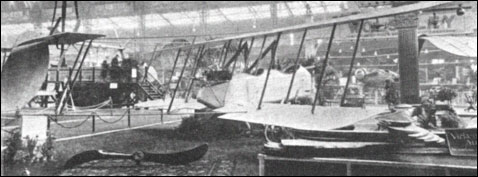|
| On 19 November 1912, Vickers received a contract from the Admiralty for an experimental fighting biplane armed with a machine gun. Various configurations were investigated before the desirability of placing the gunner in the extreme nose of the aircraft, in order to achieve a clear field of fire, led to choice of a fuselage nacelle carrying at its rear an engine driving a pusher propeller. This nacelle was mated with an unequal-span heavily-staggered biplane configuration, the tail surfaces being carried by paired and vertically disposed booms attaching to the upper and lower rear wing spars on each side of the engine. Designated E.F.B. (Experimental Fighting Biplane) 1 and dubbed "Destroyer", the Vickers aircraft was, if not the very first, then one of the earliest dedicated fighter aircraft, and was armed with a single 7.7mm Maxim machine gun on a mount affording 60° elevation and traverse. The airframe of the E.F.B.1 was primarily of metal construction, the nacelle accommodating the pilot and gunner, and carrying an 80hp Wolseley eight-cylinder Vee-type engine, being of steel tube with duralumin skinning. Wing warping was employed for lateral control. Prior to its first flight, the E.F.B.1 was displayed at the Aero Show held at Olympia, London, in February 1913. The gun was fitted for the first flight test, made at Joyce Green, but this rendered the aircraft so nose-heavy that it briefly left the ground, then nosed down, struck the ground and turned over.
 | A three-view drawing (1280 x 898) |
| WEIGHTS |
| Take-off weight | 1207 kg | 2661 lb |
| Empty weight | 798 kg | 1759 lb |
| DIMENSIONS |
| Wingspan | 12.19 m | 40 ft 0 in |
| Length | 8.38 m | 28 ft 6 in |
| Height | 3.63 m | 12 ft 11 in |
| Wing area | 35.77 m2 | 385.02 sq ft |
| PERFORMANCE |
| Max. speed | 113 km/h | 70 mph |
| bingfaren, 20.06.2011 06:00 The gun was fitted for the first flight test, made at Joyce Green, but this rendered the aircraft so nose-heavy that it briefly left the ground, then nosed down, struck the ground and turned over. reply |
|
Do you have any comments?
|
| 
COMPANY
PROFILE
All the World's Rotorcraft
|







